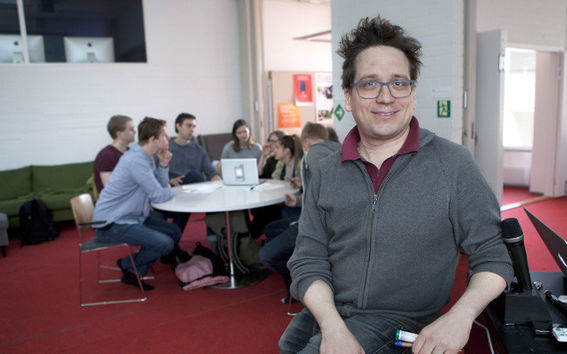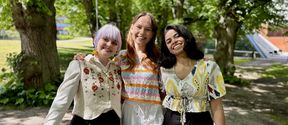Flipped learning in groups – a new way of teaching

Students participating a Bachelor course in water and environmental engineering use flipped and peer learning in study groups to absorb and analyse new information. The feedback provided by the students has been positive.
University lecturer Marko Keskinen received the annual teaching award of the Aalto University School of Engineering (AaltoENG). According to the award justifications, Keskinen's teaching has been planned so that it forms a functional whole that supports the learning process of students.
Around 150 students participate in the water and environmental engineering course for bachelor's degree students. When Keskinen was planning the course, he pondered how he could make such a a large course as interactive, student-centred and inspiring as possible.
The lecturer decided to build on a combination of flipped learning and peer learning. So-called reading circle groups or study groups (lukupiiriryhmät) are used during the course, but the traditional order of first giving a lecture and then discussing the lecture in study groups has been reversed.
‘The idea is that the students first read the provided material independently and then discuss it in the study groups. In this way they learn predominantly from each other (peers) and not only from the teacher’, Keskinen explains.
Making use of e-learning environment
Advanced e-learning technology helps in adopting new teaching methods.
‘We use different online learning tools to facilitate discussion and share reading material. On bachelor courses it is important that students can connect theory with practice. This is why the reading material can include various documents, ranging from our own, more theoretical publications to policy documents and even news stories, Keskinen says.
The students access all reading material through the new MyCourses e-learning environment adopted at Aalto University. This autumn MyCourses is also used for weekly exercises; students access and submit all exercises electronically. Also assessment and grading is done in MyCourses. The web-based activation tool Presemo is also used during the course to report back from group discussion and to facilitate discussion with the lecturer.
”MyCourses e-learning environment have supported the course very well. With so many students it is important that all the information and material is easily available, and that it is possible to submit and assess the different assignments electronically”, Keskinen notes.
The study group meetings and lectures are held on the same day and at a specific time so that students do not have to separately agree on each meeting. One hour has been reserved for study group discussions. The discussions are summarised in Presemo, where each group adds two synthesising questions for the other groups and lecturer to see. Sometimes Presemo is used to organise a poll related to the theme of the day.
‘Polls related to actual, real-life cases have been an excellent way of presenting different points of view. They also help students to see how their own interpretations on these issues are formed’, Keskinen says.
The questions entered in Presemo are discussed together. When asked, the groups also need to provide some background information related to their questions. This ensures that everyone has enough information to be able to participate in the joint discussion. The discussion is followed by a concise half-hour lecture.
Precise instructions
At the beginning of the course, the groups discuss together with the lecturer about the team roles that people usually take during team work as well as about the different stages of group work and the related pitfalls.
‘On a course that builds on peer learning, students must have a clear framework so that they know how the course will progress, how their learning will be evaluated and, overall, what is expected from them. Then you just have to trust the students to get on with it: freedom and responsibility must go hand in hand.’ Keskinen explains.
The students evaluate the work of all group members, including themselves, twice during the course. The evaluation includes a grade as well as a verbal assessment. According to Keskinen, the system has worked brilliantly.
‘The students receive valuable feedback on their team working and interaction: both are also very important working life skills but you rarely have a chance to get constructive feedback on them.’
Self-assessment important part of the learning process
In addition to study groups and lectures, the students learn basic computational and problem-solving methods through weekly exercises. These exercises are performed independently.
‘When I asked the students' opinion on how they wanted to perform the weekly exercises, the message was clear: please let us do something on our own!’ Keskinen says.
The course does not include an examination. The course grade is based on the weekly exercises (50%) and the work performed in the study group (50%).
Fifty percent of the study group grade is based on each student's self-evaluation and the evaluation by the other members of the group. According to Keskinen, this is essential: when students are given more responsibility for their own learning, they must also have the opportunity to evaluate their performance.
Peer evaluation has not led to students giving ‘too good’ grades to each other or themselves. On the contrary: the majority of the students is more critical towards their own work than their own peers.
‘Achieving good learning results is naturally more important than the grades. The flipped peer learning method encourages students to read the material in advance. Not many are willing to be free riders and leave the work to the other members of the study group. Peer pressure works better than the teacher's control.’
Keskinen says that one of the challenges in planning the course is how to make it inspiring to those students for whom the course is only a compulsory minor subject. In fact, this is the case for the majority of the students.
‘Some students wrote to course feedback that they learned a lot although they were not that interested in the topics of the course. I think that's one of the best pieces of feedback I have received from this course.’
A change of mindset needed
This kind of flipped peer learning requires a change in the mindset of both teachers and students.
According to Keskinen, some of the students are against the idea of study groups at first, and would much rather just do an exam. Once the study groups get going, the students usually change their mind, and the feedback received after the course has mostly been very positive.
‘Students soon notice that the study groups work. They also even out the workload so that there is not too much work at the end of the course. The study groups give students more responsibility, and enthusiasm usually grows as the group members get to know each other, Keskinen says.
Visiting lecturers also have to adapt their teaching methods to the course. The lecture can only last 30 minutes, and preparing the reading material and engaging in the discussions will take up more time than on a normal course. Keskinen says that as a whole, the teachers' workload does not differ much from the workload of more conventional courses.
‘The lecture sessions have worked well. The thanks goes to my brilliant colleagues who have approached the new concept with an open mind. Big thanks goes also to course assistants, who have ensured that the course runs so smoothly particularly this autumn when I have been hands full with work on our new Master’s Programme.’
Same approach is applicable also elsewhere
These same kinds of ideas about student centred and interactive learning are used also in Aalto’s new Master’s Programme in Water and Environmental Engineering that Keskinen coordinates. “Our new Master’s Programme brings together students with very different backgrounds. So peer learning is critical there as well, as it ensures that students make better use of their differing knowledge and skills”, Keskinen notes.
Keskinen has also presented his method about flipped peer learning at PedaForum. Based on the presentations and follow-up discussions with colleagues from other universitities, the idea has also been applied at the University of Eastern Finland and the National Defence University.
‘I created my combination of flipped and peer learning during Aalto University’s excellent pedagogical studies. I learned and observed different teaching methods, and used several different ideas and combined them into this method. I hope that the idea about flipped peer learning will inspire others to think about new ways of teaching: the method can freely be applied!’ Keskinen concludes.
Read more news

Online AI course could boost study equality
Students at the School of Business believe that mastering Artificial Intelligence (AI) can be beneficial for both academic success and career prospects, as AI becomes increasingly integrated into daily life.
2 027 new students admitted to Aalto University’s Finnish, Swedish bachelor’s programmes
13 500 applied to Aalto University in Finland's spring joint application in 2024
Meet the the Program Assistants that elevate the Aalto University Summer School experience for 250 students from all over the world
Each year, the Aalto University Summer School has grown its operations and course curriculum tremendously.